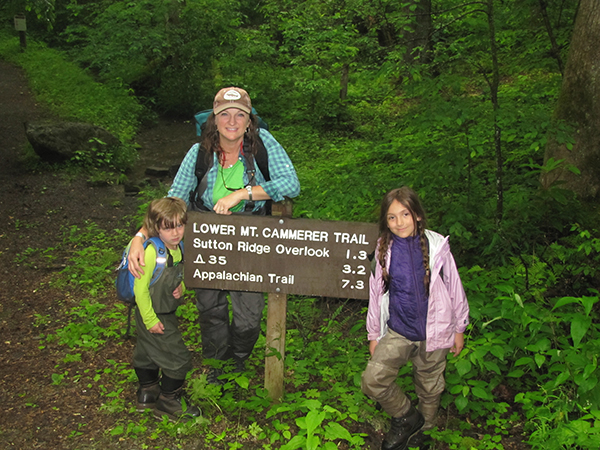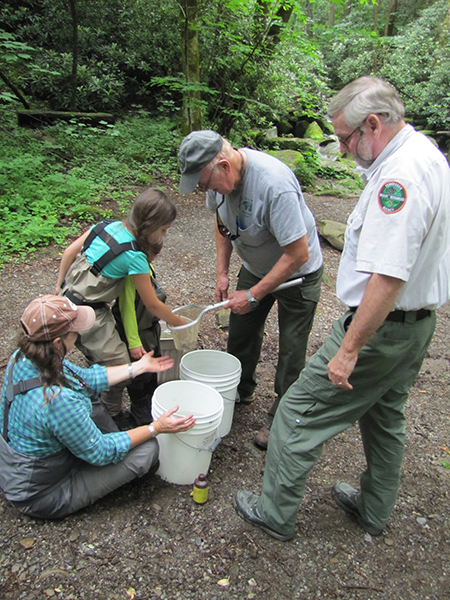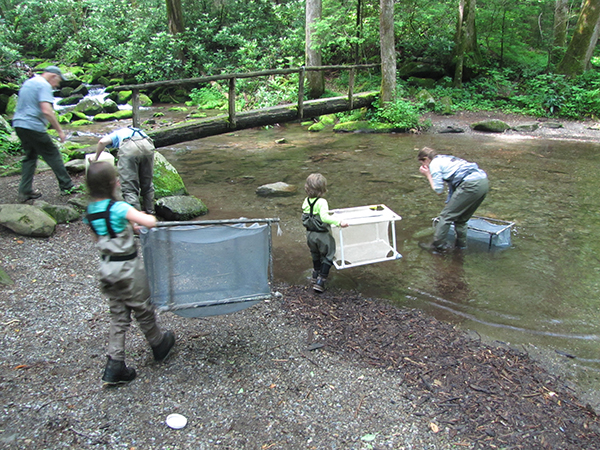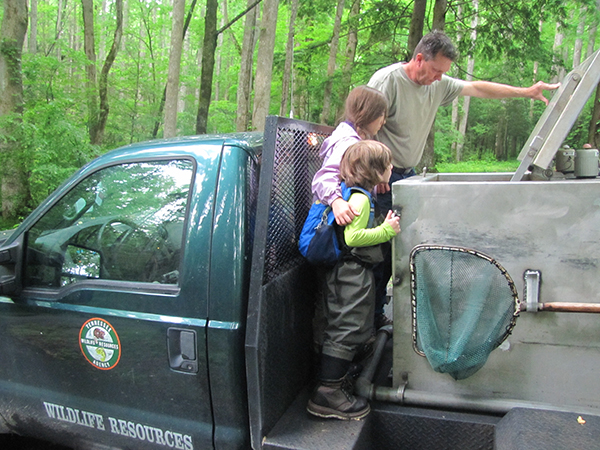Anyone who’s known us or followed us for very long knows we have a soft spot for wild, native brook trout here in the Smoky Mountains. These fish have persisted for thousands of years against everything Mother Nature and mankind has thrown at them. Even as their numbers have diminished significantly over the last century they have made somewhat of a comeback over the last decade. Most of that has been because of restoration efforts by biologists and Trout Unlimited volunteers inside Great Smoky Mountains National Park.
Fisheries biologists capturing trout near Cosby, TN for reintroduction into a stream near Townsend, TN
We’ve been big supporters of these projects and volunteered whenever possible. In one instance this included carrying a five gallon container full of natives seven miles down a trail to a state stocking truck where they were then transported to another stream for re-introduction. As fly fishing guides we rely on trout to make a living, and we guide because we have a love for trout and the waters where they live. We try to instill our values into our children as any parent would and now they have also helped with native brook trout restoration in the Smokies. Last week Charity took our kids to help collect brook trout from Tom’s Creek near Cosby for relocation to Lynn Camp Prong.

Charity, Boone, and Willow at the trailhead where they hiked in to help collect brook trout to take to their home stream
The Lynn Camp Prong restoration in the Tremont section of the Smokies is the most ambitious one by far in the park and happens to practically be in our back yard. It’s about 10 minutes to the park line from our house plus another 15 minutes of driving up a gravel road to get there. The view from our house includes the peaks and ridges drained by this stream and we spend plenty of time hiking and picnicking there. We used to fish this stream frequently when it had rainbow trout in it and were understandably concerned when we heard it would be closed to fishing for a brook trout restoration.
This has been going on for several years and to be honest, we really expected this project to be complete by now. Things rarely go as planned and the cold hard facts are that this is a relatively large stream to remove rainbow trout from and reintroduce natives back into. The project has taken longer than even the biologists who spearheaded the effort expected.
The brookies don’t come from a hatchery, they come from neighboring streams in the Smokies since our natives are genetically distinct. This makes for some complications since you just can’t wipe out the population of one stream and move it somewhere else. Also, two consecutive seasons of late fall and early winter flooding have severely limited spawning so reproduction has been limited not only on Lynn Camp Prong, but all brook trout streams in the region.
Fisheries biologists say that the higher elevations of Lynn Camp Prong have good populations of brook trout now, but the lowest and most accessible sections of the stream are still lightly populated. This is pretty big water as far as brook trout water is concerned and as a result, high water probably did more scouring of redds where eggs were laid. (Notice the size of the stream in the video where the kids release the fish. More fish were collected from Tom’s Creek near Cosby, TN last week and brought to Lynn Camp Prong. Charity checked with the biologists to see if it would be all right for our children to come along and they were excited at the idea of their participation.
Our kids have literally grown up on trout streams and rivers so while the scenery was all too familiar the method of using electrofishing equipment to catch fish was not. (Quick aside about the children of fly fishing guides: About a month ago Boone saw a sign for nightcrawlers in a local gas station and corner market and wondered why anyone would buy worms. I told them that people use worms to catch fish. His puzzled response was “Fish eat WORMS???? I thought they ate mayflies and stoneflies!”)
If you’re not aware of the method biologists wear backpack generators and an electrical current passes between two probes they place in the water. The electricity stuns the fish and makes it relatively easy to net them.

Charity & the kids counting the fish with retired park biologist Steve Moore and TWRA cold water biologist Rick Bivens
The fish are then placed in a bucket of water then kept in mesh cages before they are moved. In this case the fish were placed in five gallon containers that can be carried on a backpack.

The kids watch as Matt Kulp sets up the battery powered aerator for the fish he’ll be packing down the trail
The fish are then carried down the trail where a trout stocking truck provided by TWRA (Tennessee Wildlife Resources Agency) can transport them on the further trip to the trailhead at Tremont. From there the fish were placed in a number of water filled plastic bags and transported via an ATV up the relatively wide and level trail to predetermined locations to place them in the stream.
Here’s a video of the day and that special moment when the kids release one of the groups of fish in a pool where they often skip rocks and swim. It’s not hard to imagine them catching fish in this same pool in the future.



Fred says
Priceless! Thanks for sharing.
Stephen Hynes says
Really enjoyed the report, photos and video. Great work. Well done.
Cheers,
Steve.
Charlie Chmielewski says
Great report and pictures. Thanks for all you do.
Drew P. says
Wow, this does my heart good! Thanks for sharing Ian!
Brandon says
Awesome kids! Thanks for sharing the video with us all